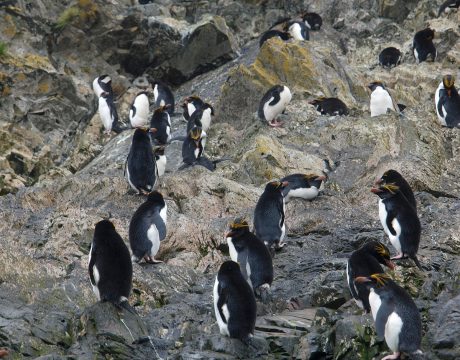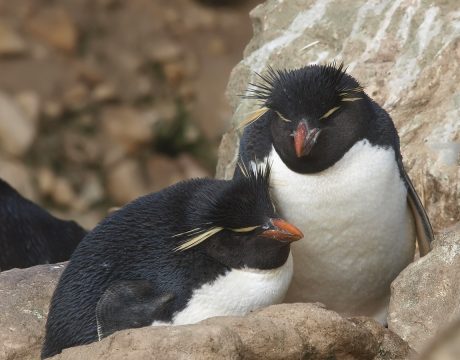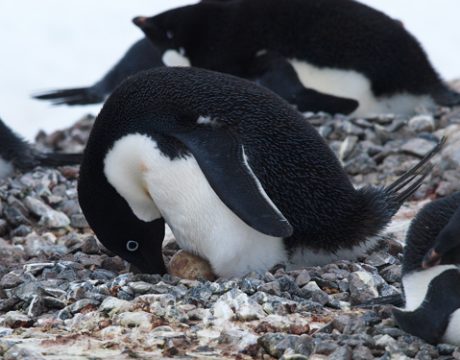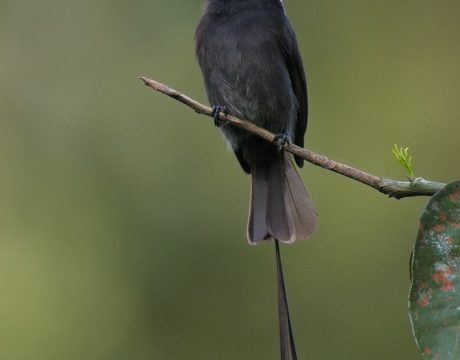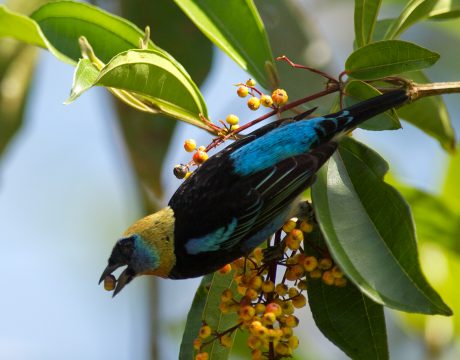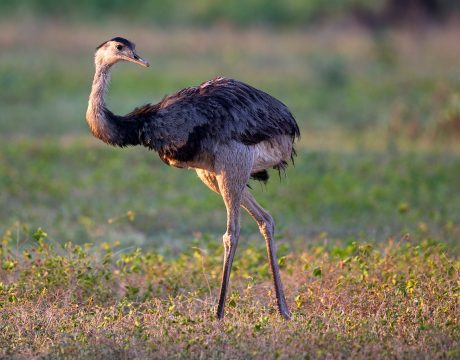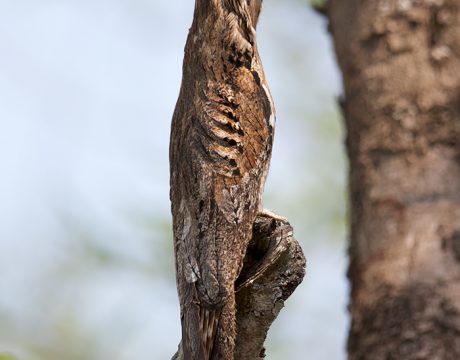Return of Bird of the Week: Macaroni Penguin
Macaroni Penguins, despite their silly name, are another amazing mountaineering species of penguin. These photos are all from a bouncing Zodiac rubber raft; we couldn’t make a landing where the Macaroni Penguins routinely did. Note the different bill structure. The Macaroni’s bill is adapted for a different genus of krill, its primary prey, resulting the bulbous shape. The feathers in the crown appear to be a sexual display thing. This is the landing for the Macaroni colony. Note the areas of bare rock, where the algae and barnacles are worn off by the passage of thousands of Macaroni feet. This…
Return of Bird of the Week: Rockhopper Penguin
One of the striking things about penguins is the steep-sided hillsides some species favor and climb to get to their rookeries. As you watch a flightless penguin waddle along, mountain-climbing isn’t the kind of skill you expect. And among the best climbers is the Rockhopper Penguin. Rockhoppers are a sub-antarctic species. These photos are from a rookery at West Point Island in the Falkland Islands. The rookery is located on a steep, rocky headland, shared with Black-browed Albatrosses and King Shags (Cormorants). It’s about 800 feet above the South Atlantic. The Rockhoppers climb that steep, slippery, rocky slope multiple times…
Return of Bird of the Week: Adélie Penguin
If WC has a favorite penguin, among the ten or so species he has seen, it has to be the Adélie Penguin. This bird is all business, all of the time. Partly, that’s because they are the most southerly-dwelling of all the penguin species. Emperor Penguins famously breed further south, but when Emperor chicks are fledged the species heads north. Adélies, by contrast, remain at the southernmost edge of open water year-round. As a species, Adélies are doing all right globally, but in the area of the Antarctic Peninsula, where WC saw them, they are in deep trouble, Adélies are…
Return of Bird of the Week: King Penguin
This week – and for the next few weeks – we’ll spend some time in the Southern Ocean. Specifically, on the extraordinary South Georgia Island. South Georgia offers concentrations of wildlife that are simply incredible. Not the least of those concentrations are the breeding colonies of King Penguins. The breeding colony at Salisbury Plain may be the largest number of breeding animals at once place left on this planet. Up to 100,000 King Penguins breed there. Ridiculously handsome, photogenic and charismatic, the King Penguin is the poster child for its clade, Spheniscidae, the penguin family. It was a privilege to visit…
Return of Bird of the Week: Resplendant Quetzal
WC has been accused of posting photos of boring birds. While there are no boring birds, it’s true that some have broader appeal than others. So here’s a lot of folks’ candidate for the most beautiful bird in the Western Hemisphere, the Resplendant Quetzal. The bird is about 15 inches long, plus about 26 inches of tail. It’s iridescent green blue and red, and seen live absolutely takes you breath away. A member of the Trogon family, it is considered divine by Mesoamerican peoples. It is certainly spectacular, and WC counts himself luck to have been able to see and…
Return of Bird of the Week: Long-tailed Tyrant
There are a staggering, bewildering number of birds in the Neotropics that eat bugs. Hundreds of species of flycatchers, alone. One of the more spectacular is the Long-tailed Tyrant. Long-tailed Tyrants feed exclusively on flying insects, especially stingless bees. Insects are captured by making quick aerial sallies from a high exposed snag or branch. Not coincidentally, that perching makes them easy to photograph. The species has an extensive range, from Honduras to Brazil, The species is described as “fairly common but patchily distributed,” but the total population is unknown and the species is, in the phrasing of ornithology, “poorly understood.” Despite that long tail,…
Return of Bird of the Week: Golden-hooded Tanager
The Golden-hooded Tanager isn’t even Costa Rica’s most spectacularly beautiful bird, but it’s pretty darn impressive.Besides, WC has neglected the avifauna of Central America. Tanagers as a group are an extensive, amazingly color family. But you are more likely to see Golden-hoodeds; they are enthusiatic visitors to fruit feeders. These photos don’t really begin to show the colors on this bird. WC supposes he will have to go back. Darn. For more bird photos, please visit Frozen Feather Images.
Return of Bird of the Week: Greater Rhea
And now for something completely different. The Greater Rhea, the signature bird species of Brazil’s Cerrado and Pantanal. The Greater Rhea is the western world’s largest bird, flightless and a cousin to the Ostriches of Africa and the Emus of Australia. They are all Ratites, a super group of large, long-legged, flightless birds. The Greater Rhea is smaller than Ostriches and Emus, but at 63 inches in height, still a very impressive bird. Ornithologists can match the speciation of Ratites to Gondwana’s plate tectonic breakup. Geology confirmed by biology; you have to like it. Among Rheas, the males raise the…
Return of Bird of the Week: Common Potoo
We’re headed to Brazil for this week’s bird, to the Pantanal, the immense swamp in southern Brazil. And the bird is the Common Potoo, a master of camouflage. You have to look closely to see the bird. Potoos are nocturnal insectivores, and during the daytime hold these vertical poses, perched motionless on the branches their coloration so strongly resembles. WC was guided to this bird by local tribe people. WC would have walked by it a dozen times without seeing it. Here’s another view. This view gives you an idea of the size of the bird’s mouth. Like their cousins,…
Return of Bird of the Week: Kelp Gull
WC doesn’t intend to neglect the Southern Hemisphere’s birds. Here is one of the most widely distributed birds of the bottom half of the planet, the Kelp Gull. It’s found throughout the Southern Ocean, from Australia to South America to Africa, and from coastal Antarctica to Ecuador. It’s probably the most widely distributed gull on the planet. An omnivore, tolerant of mankind’s activities and highly adaptable, you have to admire it even if you don’t like it dining menu, which includes penguin chicks and carrion. Kelp Gulls are three year gulls; that is, they take three years to reach maturity….





